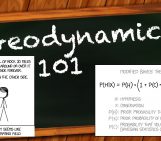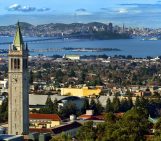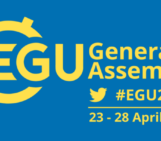
Every week, The Sassy Scientist answers a question on geodynamics, related topics, academic life, the universe or anything in between with a healthy dose of sarcasm. Do you have a question for The Sassy Scientist? Submit your question here or leave a comment below.
In a comment on a post about the key papers in geodynamics, the Curmudgeonly Commenter asked:
Could you please point out some exceptionally important papers in geodynamics and tell us something interesting about the history of the field?
Dear CC,
I feel like a lifetime has passed since I first started answering your question. I hope you are satisfied with the extent of the response. Please don’t ever ask me a question again. Really, I’ve got some important research to do. This is supposed to be some light-hearted banter, not some in-depth material acquisition you can put in your Introductions.
Additional spatio-temporal complexities
Of course, by now you realise that we must know everything about the earthquake cycle. We comprehend exactly what types of deformation takes place at different depths along-dip a fault interface, and no new features are observed anymore. Well, you’re quite mistaken. Not that long ago, a whole new can of worms was opened with the seismological and geodetic discovery of non-volcanic tremor, also dubbed Low-Frequency Earthquakes (LFEs), which corresponds to events known as Episodic Tremor and Slip (ETS) — this is basically the release of a certain seismic moment over a prolonged period of time instead of a single, finite rupture/earthquake (Hirose et al. 1999, Dragert et al. 2001, Obara 2002). The time period over which these occur is variable and segmented along-strike a single, continuous fault interface (Takagi et al. 2019, Rousset et al. 2019a), and are not restricted to subduction interfaces only (Rousset et al. 2019b). Such effect of along-strike locking variability is a common observation (e.g., Métois et al. 2016) and has direct consequences for the accumulation of slip deficit along-strike a subduction interface (e.g., Herman et al. 2018), i.e., an inherent effect of the presence of finite asperities.
Semantics
Lastly, let’s follow Wang and Dixon (2004) closely as they warn about the pitfalls of semantics. Different sub-fields — and I’m not just talking about geodynamics on it own — can understand the same word to mean something different. In this, Wang and Dixon (2004) use “coupling” as a common example of a term where kinematic observations are intertwined with dynamics terms of interaction. One could easily offer up other terms, such as e.g. “afterslip”, that do not have a clear-cut definition but is widely thrown around to mean ‘something that happened after a major earthquake occured’. Let’s not let all of our hard work be in vain by using terminology we either simply misuse, or overly complicate. It never hurts to explicitly explain what you mean with the terminology you use, even though it is crystal clear to you. Just a little tip.
So tell me, Curmudgeonly Commenter, did you learn anything about earthquakes? Was I clear and extensive enough for you? Happy at long last with my response? Let me know in the comments…
Yours truly,
The Sassy Scientist
PS: This series of posts was written with inspiration of the older papers, before the 60’s especially; they’re a lot of fun and meanwhile you’ll obtain some ideas to present in your undergraduate courses. In case you’re working on the earthquake cycle, from a geodynamics or rock mechanics perspective, especially but not exclusively on facets I haven’t mentioned above, I endorse/recommend/applaud mentioning it in the comment section. Or contact us for a proper guest author post! Get your word out to the public and get people interested.
References: Dragert, H., Wang, K. and James, T.S. (2001), A silent slip event on the deeper Cascadia subduction interface. Science, 292, 1525–1528, doi:10.1126/science.1060152. Herman, M.W., Furlong, K.P. and Govers, R. (2018), The accumulation of slip deficit in subduction zones in the absence of mechanical coupling: Implications for the behavior of megathrust earthquakes. Journal of Geophysical Research: Solid Earth, 123, 8260–8278. https://doi.org/10.1029/2018JB016336. Hirose, H., Hirahara, K., Kimata, F., Fujii, N. and Miyazaki, S. (1999), A slow thrust slip event following the two 1996 Hyuganada earthquakes beneath the Bungo Channel, southwest Japan. Geophysical Research Letters, 26( 21), 3237–3240, doi:10.1029/1999GL010999. Métois, M., Vigny, C. and Socquet, A. (2016), Interseismic coupling, megathrust earthquakes and seismic swarms along the Chilean Subduction Zone (38°–18°S). Pure and Applied Geophysics, 173(5), 1431–1449. https://doi.org/10.1007/s00024-016-1280-5. Obara, K. (2002), Nonvolcanic deep tremor associated with subduction in Southwest Japan. Science, 296, No. 5573, 1679-1681. Rousset, B. (2019a), Months-long subduction slow slip events avoid the stress shadows of seismic asperities. Journal of Geophysical Research: Solid Earth, 124. https://doi.org/10.1029/2019JB018037 Rousset, B., Bürgmann, R. and Campillo, M. (2019b), Slow slip events in the roots of the San Andreas fault. Science Advances, doi:10.1126/sciadv.aav3274 Takagi, R., Uchida, N., and Obara, K. (2.019), Along‐strike variation and migration of long‐term slow slip events in the western Nankai subduction zone, Japan. Journal of Geophysical Research: Solid Earth, 124, 3853–3880. https://doi.org/10.1029/2018JB016738. Wang, K. and Dixon, T.H. (2004), “Coupling” semantics and science in earthquake research. Eos, Transactions of the American Geophysical Union, 108, 180, https://doi.org/10.1029/2004EO180005 Zebker, H.A., Rosen, P.A., Goldstein, R.M., Gabriel, A. and Werner C.L. (1994), On the derivation of coseismic displacement fields using differential radar interferometry—the Landers earthquake. Journal of Geophysical Research, 99:19617–34.





The Curmudgeonly Commenter
Hopefully this is a stupid question, but what is an earthquake?
(Just joking! You may rest now, my sassy guru. Fascinating stuff, and no one will ever accuse you of laziness again. Maybe obsessiveness.. ^_^ )